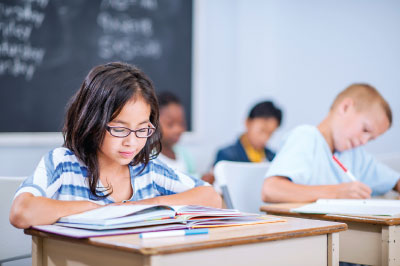‘Lazy Eye’ May Affect How Children Perceive Certain Competencies
Abstract
The lower self-perception of children with amblyopia is tied to slower reading speed and worse motor skills.
Some children who have amblyopia, or “lazy eye,” may think of themselves as less able to do well in school, have a good social life, and play sports, according to a study posted November 15 in JAMA Ophthalmology.

The idea behind VCU’s “mini-university” on mental health was to educate legislators before a crisis happens, says Joel Silverman, M.D.
Amblyopia is a condition in which one eye has poor or blurry vision, and the poor vision is not caused by a problem with the eye’s health and cannot be corrected with lenses.
Eileen E. Birch, Ph.D., of the Retinal Foundation of the Southwest in Dallas and colleagues assessed self-perception in 81 children aged 8 to 13 years. The children were divided into three groups: the amblyopia group, the nonamblyopia group, and the control group. There were 50 children in the amblyopia group. The 13 children in the nonamblyopia group had mild strabismus (eye misalignment), anisometropia (unequal focus between eyes), or both. Nearly all of the children in the first two groups wore eyeglasses. The 18 children in the control group had no vision or eye problems, and none wore eyeglasses.
Birch and her colleagues assessed the children’s self-perception using the Self-Perception Profile for Children, which covers five domains: scholastic, social, and athletic competence; physical appearance; and behavioral conduct. It also includes a separate measurement of children’s overall sense of their worth as a person. The researchers also evaluated reading and motor skills in the amblyopia group. They did not test these skills in the nonamblyopia group because of time constraints, Birch said, noting that the tests take about an hour per child.
Scores for physical appearance, behavioral conduct, and global self-worth did not differ significantly among all three groups. However, compared with the control group, children in the amblyopia group had significantly lower self-perception of their scholastic, social, and athletic competence. The researchers found that the slower the children’s reading speeds were, the lower their scores were on self-perceived scholastic competence. They also found that the less accurate the children were at aiming and catching, the lower their scores were on self-perceived scholastic, social, and athletic competence.
Like the children in the amblyopia group, the children in the nonamblyopia group had significantly lower scores for social and athletic competence than the children in the control group. However, unlike the amblyopia group, their scores for scholastic competence did not significantly differ from those of the control group.
Birch said that her team’s prior research may help explain why only children in the amblyopia group had more negative views of their scholastic competence.
“We have shown that amblyopia, but not nonamblyopic strabismus or anisometropia, is associated with slower reading speed, and that this is related to [the] abnormal eye movements and unstable fixation associated with amblyopia. We have also shown that amblyopic children are slower at completing Scantron answer sheets,” Birch said.
The abnormal binocular vision inherent in amblyopia, strabismus, and anisometropia may explain why children in both the amblyopia and nonamblyopia groups had lower social and athletic scores than the control children, Birch told Psychiatric News.
“Amblyopic children have impaired vision in the affected lazy eye and also have abnormal binocular vision. Either or both of these may cause the lower self-perception scores we observed. [But] nonamblyopic children with strabismus or anisometropia [also have] abnormal binocular vision,” Birch explained.
“Because both the amblyopic and nonamblyopic children had lower scores on the social and athletic scales, it suggests that these scales may be influenced by the binocular vision deficit, while the scholastic scale changes appear to be the results of the reduced visual acuity and resultant fixation instability associated with amblyopia,” Birch said.
In their paper, Birch and her colleagues also noted that wearing eyeglasses could also contribute to altered self-perception of social and athletic competence in the amblyopic and nonamblyopic groups.
In a commentary on the study, Joseph L. Demer, M.D., Ph.D., noted that the treatments for amblyopia may contribute to events that influence how children with amblyopia perceive themselves.
Demer noted that amblyopia treatment with eyeglasses and patches may provoke stigmatization and being bullied, but that the treatment with atropine eyedrops may relieve some of the psychological burden on the child.
Demer added that while treating amblyopia may be helpful, particularly when a child’s amblyopia improves from profound to mild, in some cases the adverse psychosocial effects of treatment may outweigh the benefits. “This may argue for a careful balancing of the family and psychosocial burdens of treatments, such as patching, against the likely improvements that can be obtained by prolonging such treatments.”
This study was supported by the National Eye Institute and the Thrasher Research Fund. ■



